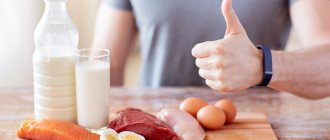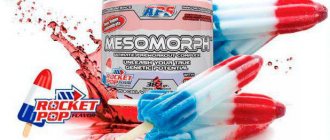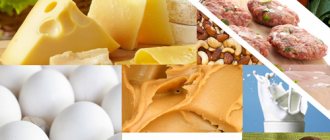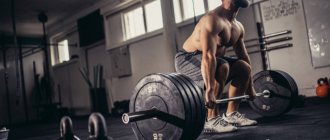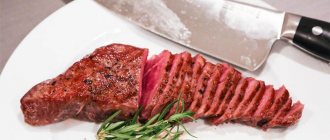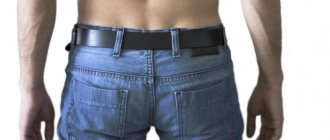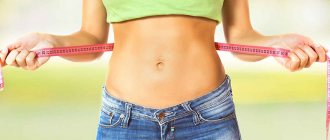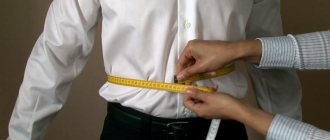When visiting the gym, a man sets specific goals for himself - to build muscle mass, get rid of excess weight, improve body contour, etc. The next important step for an athlete is choosing a diet and creating a diet that is appropriate for the task at hand. The question remains relevant at all times: “how to burn fat while maintaining the muscles acquired through labor and sweat? Is it possible"? Let's find out!
If losing weight and gaining muscle mass are incompatible, then maintaining a diet to reduce the percentage of subcutaneous fat and preserve muscle mass is quite possible.
A diet for athletes in combination with systematic training and adherence to a regimen helps fight for every gram of muscle gained through back-breaking work. However, do not forget that a calorie deficit will in any case lead to the loss of muscle fiber.
Another question is how to minimize the risk of tissue destruction? This is exactly what we will be talking about:
- what is a sports diet for men, the effectiveness of the method for losing weight in problem areas;
- advantages and disadvantages of the method, contraindications;
- correct ratio of nutrients in the diet;
- how to create a menu for a sports diet;
- general recommendations.
What is a men's sports diet
The success of achieving a sports result in the context of body building is expressed in the ratio:
- 80% - following a healthy diet, maintaining a diet for men in order to lose weight;
- 20% is the training process.
Even crazy high-intensity interval training (HIIT) will not lead to your desired goal without a well-designed nutrition plan.
To lose body fat and change your body composition, you need to have a powerful metabolism. It will not be possible to achieve a response from the body if you abuse junk food and have nutritional deficiencies.
Healthy eating can also delay the achievement of results if there is an excess of energy coming from food. Therefore, a sports diet for burning fat for men is important when setting goals.
Rules
Fat does not turn into muscle - the tissues have different structures, but the property of combustion is characteristic of both components. A diet suitable for performing athletes and men training for themselves will help prevent muscle breakdown. It is recommended to adhere to a number of rules:
- first of all, it is important to calculate the daily energy requirement, determine the calorie deficit for weight loss in order to avoid a slowdown in metabolism and keep track of the food eaten;
- consumption of at least 1.8 g of protein per 1 kg of net weight (body weight excluding body fat);
- compliance with the drinking regime - at least 2 liters per day;
- complex (slow) carbohydrates predominate in the menu, and simple ones are excluded;
- be sure to add fiber to the menu, which cleanses the intestines, promotes the digestion of protein foods and dulls the feeling of hunger.
Advantages and disadvantages
A sports diet is distinguished by a wide variety of products that provide the supply of macro and microelements to maintain full functioning and training. There is no feeling of hunger when following a sports nutrition regimen, which eliminates the risk of failure.
Sticking to a diet is easy, but the regime has a number of disadvantages:
- to achieve a sculpted body, a diet for athletes to burn fat involves mandatory physical activity;
- in large quantities, protein overloads the liver and kidneys;
- not suitable for people with gastrointestinal problems (requires consultation with your doctor).
The disadvantages of the approach are minor compared to the disadvantages of the keto diet, which involves the almost complete elimination of carbohydrates. When drawing up a nutrition plan, it is recommended to carefully monitor the balance of dietary fat and calorie intake to reduce the risk of deterioration in health.
It is important to know
Before you start a diet, study these facts, which are of great importance in understanding the process of losing weight.
There is no local weight loss. When you diet and engage in active physical exercise, fat is burned evenly throughout the body. That is, losing weight only in the hips or waist by burning fat will not work. By regulating nutrition and active loads, you can correct the shape of the muscles, thereby forming the desired curves of the body.
You can really lose weight only by dieting. Without restricting your diet, this will not happen.
And it is also important to understand that fasting is not a diet. We do not recommend that you fast, because after the resulting stress, the body will begin to intensively accumulate fat, waiting for the next such “action”
Calorie counting. Calculate how many kilocalories your body uses at rest. To do this, multiply your body weight by a factor of 0.9 - this is the calculation of kilocalories per hour. Multiply by 24 to get the final number. The body also spends energy on work and physical activity. Everyone here has their own expenses.
For comparison, in an hour of fitness training, the body absorbs a number of calories equal to body weight multiplied by a factor of 6.3. The total value of all costs is the daily energy consumption of your body. To start the weight loss process, you need to consume 400-500 kilocalories less in food every day.
Metabolism, the metabolism necessary in the process of losing weight, starts with proper nutrition, normal physical activity, proper sleep patterns and giving up bad habits.
It is necessary to drink 1.5-2 liters of clean water per day. Be sure to take it in the morning on an empty stomach. Water starts the stomach, cleanses it, prepares it for new food. And drink a glass and a half 25-30 minutes before meals. It is also believed that when the stomach is filled with water, much less is eaten.
Sports diets for men
The basis for sports diets for various tasks is identical, only the daily calorie intake and energy consumption on training and rest days differ.
For weight loss
When the goal of maintaining a sports diet is to lose excess weight, it is important to control caloric intake and dietary fat. You can reduce your caloric intake by:
- replacing bakery products and bread with whole grain bread;
- transfer part of the consumed carbohydrates to fiber;
- when choosing meat, give preference to lean varieties;
- choose fillet from chicken, turkey;
- milk, low-fat dairy products.
Sports supplements such as L-carnitine and specialized fat-burning complexes will help increase energy consumption during training. Improves weight loss and the functioning of the body as a whole, a complex of omega-3, omega-6 fatty acids.
Contain polyunsaturated fats in nuts, fatty fish, and vegetable oils. The deficiency of substances is replenished with pharmaceutical drugs.
For weight gain
Gaining muscle mass is not just about hard training in the gym with additional weights. To achieve the goal, it is important to take a serious approach to the diet - athletes increase caloric intake by adding mainly protein and carbohydrate foods.
Without a calorie surplus, no training program will work on mass gain.
Fully or partially limited products
The sports diet diet excludes the following types of foods:
- Fatty varieties of red meat (pork), goose, duck, smoked meats, sausages, animal fats, canned food, semi-finished products, fast food, fried foods.
- Products containing food additives.
- White bread, puff pastry products, pastries, semolina, pastries, cakes, pancakes, dumplings, dumplings, crackers, cookies, waffles.
- Chocolate, ice cream, sugar, honey, condensed milk, preserves, jams, candies, sweet desserts, dried fruits (figs, prunes, raisins, dried apricots, dates).
- Egg yolks, salt, fatty sauces.
Table of prohibited products
| Proteins, g | Fats, g | Carbohydrates, g | Calories, kcal | |
Vegetables and greens | ||||
| radish | 1,2 | 0,1 | 3,4 | 19 |
| white radish | 1,4 | 0,0 | 4,1 | 21 |
| red radish | 1,2 | 0,1 | 3,4 | 20 |
| black radish | 1,9 | 0,2 | 6,7 | 35 |
| spinach | 2,9 | 0,3 | 2,0 | 22 |
| sorrel | 1,5 | 0,3 | 2,9 | 19 |
Fruits | ||||
| bananas | 1,5 | 0,2 | 21,8 | 95 |
Berries | ||||
| grape | 0,6 | 0,2 | 16,8 | 65 |
Mushrooms | ||||
| mushrooms | 3,5 | 2,0 | 2,5 | 30 |
Nuts and dried fruits | ||||
| raisin | 2,9 | 0,6 | 66,0 | 264 |
Cereals and porridges | ||||
| semolina | 10,3 | 1,0 | 73,3 | 328 |
| white rice | 6,7 | 0,7 | 78,9 | 344 |
Flour and pasta | ||||
| pasta | 10,4 | 1,1 | 69,7 | 337 |
Confectionery | ||||
| jam | 0,3 | 0,2 | 63,0 | 263 |
| jam | 0,3 | 0,1 | 56,0 | 238 |
| candies | 4,3 | 19,8 | 67,5 | 453 |
| pastry cream | 0,2 | 26,0 | 16,5 | 300 |
| cookie | 7,5 | 11,8 | 74,9 | 417 |
Ice cream | ||||
| ice cream | 3,7 | 6,9 | 22,1 | 189 |
Cakes | ||||
| cake | 4,4 | 23,4 | 45,2 | 407 |
Chocolate | ||||
| chocolate | 5,4 | 35,3 | 56,5 | 544 |
Raw materials and seasonings | ||||
| mustard | 5,7 | 6,4 | 22,0 | 162 |
| mayonnaise | 2,4 | 67,0 | 3,9 | 627 |
Dairy | ||||
| milk 3.6% | 2,8 | 3,6 | 4,7 | 62 |
| milk 4.5% | 3,1 | 4,5 | 4,7 | 72 |
| cream | 2,8 | 20,0 | 3,7 | 205 |
| sour cream 25% (classic) | 2,6 | 25,0 | 2,5 | 248 |
Cheeses and cottage cheese | ||||
| cheese | 24,1 | 29,5 | 0,3 | 363 |
| cottage cheese 11% | 16,0 | 11,0 | 1,0 | 170 |
| cottage cheese 18% (fat) | 14,0 | 18,0 | 2,8 | 232 |
Meat products | ||||
| pork | 16,0 | 21,6 | 0,0 | 259 |
| pork liver | 18,8 | 3,6 | 0,0 | 108 |
| pork kidneys | 13,0 | 3,1 | 0,0 | 80 |
| pork fat | 1,4 | 92,8 | 0,0 | 841 |
| salo | 2,4 | 89,0 | 0,0 | 797 |
| beef liver | 17,4 | 3,1 | 0,0 | 98 |
| beef kidneys | 12,5 | 1,8 | 0,0 | 66 |
| beef brains | 9,5 | 9,5 | 0,0 | 124 |
Sausages | ||||
| smoked sausage | 16,2 | 44,6 | 0,0 | 466 |
| smoked sausage | 9,9 | 63,2 | 0,3 | 608 |
| sausages | 10,1 | 31,6 | 1,9 | 332 |
| sausages | 12,3 | 25,3 | 0,0 | 277 |
Bird | ||||
| smoked chicken | 27,5 | 8,2 | 0,0 | 184 |
| duck | 16,5 | 61,2 | 0,0 | 346 |
| smoked duck | 19,0 | 28,4 | 0,0 | 337 |
| goose | 16,1 | 33,3 | 0,0 | 364 |
Fish and seafood | ||||
| smoked fish | 26,8 | 9,9 | 0,0 | 196 |
| salted fish | 19,2 | 2,0 | 0,0 | 190 |
| Red caviar | 32,0 | 15,0 | 0,0 | 263 |
| black caviar | 28,0 | 9,7 | 0,0 | 203 |
| canned fish | 17,5 | 2,0 | 0,0 | 88 |
| cod (liver in oil) | 4,2 | 65,7 | 1,2 | 613 |
Oils and fats | ||||
| animal fat | 0,0 | 99,7 | 0,0 | 897 |
| cooking fat | 0,0 | 99,7 | 0,0 | 897 |
Non-alcoholic drinks | ||||
| instant coffee dry | 15,0 | 3,5 | 0,0 | 94 |
| black tea | 20,0 | 5,1 | 6,9 | 152 |
| * data is per 100 g of product | ||||
Weekly sports menu for men
The presented menu will form an understanding of what a sports diet looks like for men. Portions and quantity of products are determined in accordance with individual calorie and nutrient needs.
| Day | Eating | Menu for the day |
| 1 day | Breakfast | Oatmeal with milk 1.5% with berries or dried fruits, boiled eggs |
| Late breakfast | Yogurt without additives, fruit | |
| Dinner | Boiled chicken fillet, buckwheat with mushrooms, fresh vegetables | |
| Afternoon snack | Whole grain bread with low fat cheese | |
| Dinner | Beef chop, fresh vegetable salad | |
| Day 2 | Breakfast | Baked sweet potato with peanut butter, omelette |
| Late breakfast | Cottage cheese up to 5% with berries | |
| Dinner | Meatball soup, vegetable salad with butter | |
| Afternoon snack | Nuts | |
| Dinner | Steamed fish cutlets, Greek salad | |
| Day 3 | Breakfast | Muesli without added sugar with milk, cottage cheese |
| Late breakfast | Low fat kefir, bread | |
| Dinner | Borsch, brown rice pilaf with chicken | |
| Afternoon snack | Fruit salad | |
| Dinner | Grilled chicken fillet, grilled vegetables | |
| 4 day | Breakfast | Buckwheat porridge with milk, chicken fillet |
| Late breakfast | Whole grain bread with cheese | |
| Dinner | Noodle soup, baked fish with vegetables | |
| Afternoon snack | Berries, nuts | |
| Dinner | Chicken fillet baked with broccoli | |
| 5 day | Breakfast | Milk rice porridge with raisins, omelette with tomatoes |
| Late breakfast | Cottage cheese casserole | |
| Dinner | Fish soup, chicken chop, Greek salad | |
| Afternoon snack | Seasonal fruits | |
| Dinner | Fish cutlets, stewed cabbage and tomatoes | |
| Day 6 | Breakfast | Cheesecakes with honey |
| Late breakfast | Yogurt, fruit | |
| Dinner | Pea soup with beef, mashed potatoes, chicken fillet | |
| Afternoon snack | Cauliflower in batter | |
| Dinner | Stewed beef with vegetables | |
| Day 7 | Breakfast | Omelet with tomatoes, bananas |
| Late breakfast | Whole grain breads with cheese | |
| Dinner | Broccoli soup, boiled chicken fillet, fresh vegetables | |
| Afternoon snack | Zucchini fritters | |
| Dinner | Baked salmon with asparagus |
Authorized Products
A sports diet includes the inclusion in the diet of such products as:
- Lean varieties of red meat (beef, veal, lamb), chicken, rabbit and turkey.
- Sea/river fish (salmon, trout, tuna, herring, cod, perch, hake, sardines, pike), seafood (crabs, squids, mussels, shrimp).
- Chicken eggs.
- Grain/yeast-free bread with bran.
- Cereals (buckwheat, oatmeal, wheat, rice), wholemeal pasta.
- Soups, cabbage soup, borscht in low-fat broth.
- Low-fat dairy/fermented milk products (milk, cottage cheese, yogurt, kefir, fermented baked milk), cheeses.
- Legumes (peas, lentils, beans, chickpeas), soybeans and soy products (tofu cheese, milk).
- Non-starchy vegetables (cucumbers, tomatoes, carrots, onions, cabbage, zucchini, bell peppers), garden herbs.
- Unsweetened fruits/berries (apples, citrus fruits, currants).
- Nuts, bran, sesame and flax seeds, sunflower seeds, seaweed.
- Unrefined vegetable oils (olive, sesame, corn, flaxseed), butter, fish oil.
- Freshly prepared juices from orange, pomegranate, apples, plums, herbal tea, rosehip infusion, green tea with lemon, purified still water, coffee.
Table of permitted products
| Proteins, g | Fats, g | Carbohydrates, g | Calories, kcal | |
Vegetables and greens | ||||
| greenery | 2,6 | 0,4 | 5,2 | 36 |
| eggplant | 1,2 | 0,1 | 4,5 | 24 |
| beans | 6,0 | 0,1 | 8,5 | 57 |
| zucchini | 0,6 | 0,3 | 4,6 | 24 |
| cabbage | 1,8 | 0,1 | 4,7 | 27 |
| broccoli | 3,0 | 0,4 | 5,2 | 28 |
| boiled cauliflower | 1,8 | 0,3 | 4,0 | 29 |
| bulb onions | 1,4 | 0,0 | 10,4 | 41 |
| carrot | 1,3 | 0,1 | 6,9 | 32 |
| cucumbers | 0,8 | 0,1 | 2,8 | 15 |
| salad pepper | 1,3 | 0,0 | 5,3 | 27 |
| salad | 1,2 | 0,3 | 1,3 | 12 |
| beet | 1,5 | 0,1 | 8,8 | 40 |
| celery | 0,9 | 0,1 | 2,1 | 12 |
| soybeans | 34,9 | 17,3 | 17,3 | 381 |
| asparagus | 1,9 | 0,1 | 3,1 | 20 |
| tomatoes | 0,6 | 0,2 | 4,2 | 20 |
| Jerusalem artichoke | 2,1 | 0,1 | 12,8 | 61 |
| pumpkin | 1,3 | 0,3 | 7,7 | 28 |
| beans | 7,8 | 0,5 | 21,5 | 123 |
| garlic | 6,5 | 0,5 | 29,9 | 143 |
| lentils | 24,0 | 1,5 | 42,7 | 284 |
Fruits | ||||
| avocado | 2,0 | 20,0 | 7,4 | 208 |
| oranges | 0,9 | 0,2 | 8,1 | 36 |
| pomegranate | 0,9 | 0,0 | 13,9 | 52 |
| grapefruit | 0,7 | 0,2 | 6,5 | 29 |
| pears | 0,4 | 0,3 | 10,9 | 42 |
| kiwi | 1,0 | 0,6 | 10,3 | 48 |
| lemons | 0,9 | 0,1 | 3,0 | 16 |
| mango | 0,5 | 0,3 | 11,5 | 67 |
| tangerines | 0,8 | 0,2 | 7,5 | 33 |
| nectarine | 0,9 | 0,2 | 11,8 | 48 |
| peaches | 0,9 | 0,1 | 11,3 | 46 |
| apples | 0,4 | 0,4 | 9,8 | 47 |
Berries | ||||
| gooseberry | 0,7 | 0,2 | 12,0 | 43 |
| Red currants | 0,6 | 0,2 | 7,7 | 43 |
| black currant | 1,0 | 0,4 | 7,3 | 44 |
Nuts and dried fruits | ||||
| nuts | 15,0 | 40,0 | 20,0 | 500 |
| cashew | 25,7 | 54,1 | 13,2 | 643 |
| sesame | 19,4 | 48,7 | 12,2 | 565 |
| flax seeds | 18,3 | 42,2 | 28,9 | 534 |
| fenugreek seeds | 23,0 | 6,4 | 58,3 | 323 |
| sunflower seeds | 20,7 | 52,9 | 3,4 | 578 |
Cereals and porridges | ||||
| buckwheat (kernel) | 12,6 | 3,3 | 62,1 | 313 |
| oat groats | 12,3 | 6,1 | 59,5 | 342 |
| cereals | 11,9 | 7,2 | 69,3 | 366 |
| millet cereal | 11,5 | 3,3 | 69,3 | 348 |
Raw materials and seasonings | ||||
| honey | 0,8 | 0,0 | 81,5 | 329 |
Dairy | ||||
| skim milk | 2,0 | 0,1 | 4,8 | 31 |
| natural yogurt 2% | 4,3 | 2,0 | 6,2 | 60 |
Cheeses and cottage cheese | ||||
| cottage cheese 0.6% (low fat) | 18,0 | 0,6 | 1,8 | 88 |
| curd tofu | 8,1 | 4,2 | 0,6 | 73 |
Meat products | ||||
| beef | 18,9 | 19,4 | 0,0 | 187 |
| rabbit | 21,0 | 8,0 | 0,0 | 156 |
Bird | ||||
| chicken fillet | 23,1 | 1,2 | 0,0 | 110 |
| turkey | 19,2 | 0,7 | 0,0 | 84 |
Fish and seafood | ||||
| fish | 18,5 | 4,9 | 0,0 | 136 |
| squid | 21,2 | 2,8 | 2,0 | 122 |
| mussels | 9,1 | 1,5 | 0,0 | 50 |
| seaweed | 0,8 | 5,1 | 0,0 | 49 |
Oils and fats | ||||
| butter | 0,5 | 82,5 | 0,8 | 748 |
| linseed oil | 0,0 | 99,8 | 0,0 | 898 |
| olive oil | 0,0 | 99,8 | 0,0 | 898 |
| sunflower oil | 0,0 | 99,9 | 0,0 | 899 |
Non-alcoholic drinks | ||||
| mineral water | 0,0 | 0,0 | 0,0 | — |
| green tea | 0,0 | 0,0 | 0,0 | — |
| * data is per 100 g of product | ||||
Indications and contraindications
Before starting a diet, every man should familiarize himself with the contraindications that lead to deterioration of health. A sports diet is not recommended:
- for diabetes mellitus;
- men with chronic diseases of the gastrointestinal tract, liver, kidneys, heart muscle.
Indications for maintaining sports nutrition:
- reducing the percentage of body fat, preserving muscles;
- supply of necessary macronutrients without radical reduction of nutrients, as required by a low-carbohydrate diet for athletes.
The feeling of hunger is not typical for a sports diet due to the balance of the nutritional supplement, so the diet is considered comfortable and does not lead to breakdowns.
Compatibility of different types of food
Many athletes believe that they can achieve faster results by consuming several types of weight loss supplements at the same time. This is not entirely true when it comes to fat burners or thermogenics. The principle of their operation is approximately the same and the active ingredients in most supplements are almost the same. Therefore, you should not use several types of fat burners at the same time. In addition, due to this, you may exceed the recommended dosage, which will lead to unpleasant consequences in the form of headaches, nausea, insomnia or increased blood pressure due to an overdose of caffeine and other substances that have a stimulating effect. For the same reason, it is not recommended to combine the use of fat burners and pre-workout complexes.
Fat burners and similar supplements can be easily combined with the following types of sports nutrition:
- protein mixtures;
- vitamin and mineral complexes;
- BCAA;
- complex amino acids;
- glutamine;
- other supplements that do not interfere with fat burning processes and do not contain a large amount of calories (for example, gainers).
pictoores - stock.adobe.com
Recommendations
Brief recommendations for men to increase the effectiveness of fat burning:
- The reduction in caloric intake occurs gradually - 50-100 calories are removed daily until the required levels are achieved. The action will reduce the risk of failure and promote adaptation to a new diet;
- portions and number of meals are formed according to the training time, daily routine, and the peculiarities of the gastrointestinal tract. The main goal is to meet your daily calorie intake;
- studying the product composition on the label will help eliminate harmful ingredients from the menu;
- recovery is an important stage. Overtraining reduces performance and slows down weight loss;
- adherence to a daily routine - sleep stimulates the production of hormones that promote weight loss;
- drinking regime - water cleanses the body and transports nutrients;
- alcohol is contraindicated on a diet, because slows down the process of getting rid of fat;
- A systematic visit to the gym helps you move forward in achieving your cherished goal and improves the quality of your body.
Questions and answers
It is important to understand common questions that arise among men when choosing a sports diet:
Is it true that eating too much protein is harmful to the body?
Those who understand little about building sculpted muscles are opposed to proteins. If for an ordinary person a lot of protein can be harmful, then when burning fat and building muscle, they are indispensable.
Is it possible to have the same ripped body as bodybuilders during competitions, but at the same time maintain muscle mass?
No. The pre-competition diet involves partial muscle loss. The body cannot burn fat without damaging muscle tissue in extreme conditions. To control muscle loss, adequate amounts of protein and fat are necessary.
Protein is needed to maintain muscle, while essential fats provide energy and support hormone levels, particularly testosterone.
What is required for beginners with average fat levels and who want to get a sculpted body: start a diet right away or first spend some time studying the issue of building muscle and then try to burn fat?
It is recommended to burn fat first. Reason: the less subcutaneous fat, the more prominent the shape looks. Increasing the muscle underneath the fat layer increases volume, but it will not look athletic. A sculpted body is always impressive and aesthetically pleasing.
After the relief muscles are clearly defined, you can begin to gain weight by increasing the number of calories.
When burning fat, should you change your workouts to work in high rep ranges with moderate weights, or continue with your normal strength program?
To maintain muscle mass, it is necessary to maintain cyclical loading. The main focus is on nutrition. Additionally, HIIT training will help create a calorie deficit without destroying muscles.
Training and sports diet for burning fat
The basis of the training program is multi-joint exercises:
- bench press;
- deep squats with a barbell;
- deadlift;
- hack squats;
- pull-ups with weights.
Building the body is a science that conceals the secrets of training and the subtleties of nutrition. The sports diet for men is a classic diet that is suitable for professionals and beginners.
In combination with a sports diet for men, we recommend the following training plan in the gym.
Sports supplements for fat burning
The following products will help you achieve results faster:
| Fat burner | Created to reduce excess fat deposits. Accelerates the breakdown of fat molecules and converts fat into free energy, increasing its consumption. |
| BCAAs | Allows muscle fibers to recover faster and provides building material for the growth of lean muscle mass. |
| Protein isolate | It features a deep degree of purification from impurities. Contains less lactose and fat, but more pure protein. Taking isolate is recommended for those who want to lose weight. |
| Pre-workout complex | Increases productivity during sports, strength, endurance, recovery speed between approaches. |
